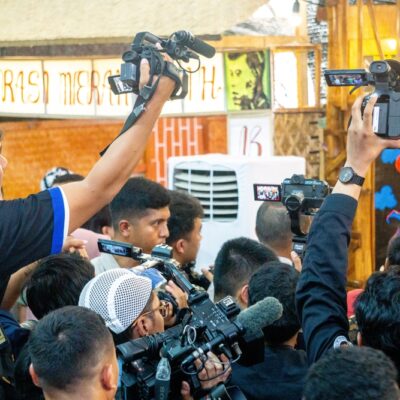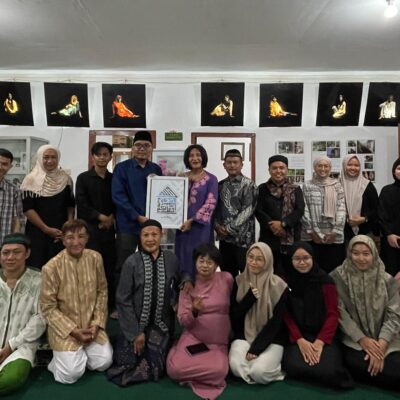Twenty years ago in 2004—the year Indonesia’s first directly-elected president, Susilo Bambang Yudhoyono, was inaugurated—prominent experts Vedi Hadiz and Richard Robison published Reorganising Power in Indonesia: The Politics of Oligarchy in an Age of Markets.
Unlike those who widely celebrated the wave of democratisation in Indonesia, Hadiz and Robison highlighted that since the fall of the authoritarian regime of Suharto in 1998 old forces had reconsolidated dominance while ‘new ones were drawn into predatory practices which had defined politics in Indonesia for decades.’
The book popularised the so-called ‘oligarchy framework’, which has sparked lively and critical discussions among academics, civil society and beyond. However, the ‘oligarchy framework’ is commonly reduced to being about a troop of powerful elites, instead of being about a more complex structural relationship of power that coherently sustains the wealth-rulership nexus. In contemporary Indonesia, it has found expression through varying institutional forms, mainly through political technocratic machinery and the development of forms of statism, such as economic nationalism and techno-industrial policy, as well as the concomitant expansion of state capitalism.
The aim of this article is to revisit the ‘oligarchy framework’, make sense of it, and draw out its relevance to the contemporary context, which includes economic (de)globalisation, the crisis of inequality and precarity, the commodities boom, the energy transition imperative, inter-state war, the rise of right-wing extremism, and climate change and environmental destruction. These dynamics have reshaped the nature of the oligarchy in Indonesia.
The current trajectory of neoliberalism and oligarchy
Hadiz and Robison wrote in a time when the world order saw Pan-Americana and then ‘Chimerica‘— a broadly cooperative pattern of economic relations between China and the US. It was also a time of so-called ‘big bang decentralisation’, which gave away control of power and resources to the subnational government, and which started to gain traction in Indonesia.
Neoliberalist market-oriented reforms, such as deregulation, privatisation, and fiscal discipline were also promoted. These so-called ‘Washington Consensus’ economic policy recommendations were promoted in the early 2000s for crisis-stricken developing countries and have since been paradoxically co-opted by politico-economic forces, both at the national and local levels to reinforce their dominance.
In contemporary times, Indonesia has seen renewed developmentalist strategies, such as nickel downstreaming, export bans, digital transformation, and infrastructure development that are touted as panaceas amid geoeconomic uncertainties. Here, we see not only the emergence of new powerful politico-economic forces seeking to capitalise on these development agendas, but also the shifting nature of the structure of oligarchy—the coalescence of capital and the state’s technocratic machines at different levels. Dynastic politics—defined as a family-based political organisation with the primary objective to secure, maintain, and expand power positions—and its embeddedness with Indonesia’s key strategic sector is a case in point.
Reformists promoting decentralisation policies in 2001 would have never imagined that one day dynastic politics would proliferate across the country. The direct local election system was first introduced in response to the excessive centralisation of power at the hands of a small group of elites and aimed to reduce corruption involving local parliamentarians during the Suharto government. Limits on the number of terms political leaders were allowed to hold were also introduced to reduce the possibility of individuals monopolising power.
In the subsequent two decades, however, dynastic politics has become an inseparable feature of Indonesia’s electoral democracy. The aim of term limits has been undermined by widespread attempts by many incumbents who cannot run for a third time to promote family members to succeed them. For example, 605 dynastic politicians competed in the 2024 simultaneous regional elections. This number is a sharp increase compared to the 361 dynastic candidates who competed in regional elections between 2015 and 2020. Although only 246 dynasty politicians emerged as victors in the 2024 direct local elections, it is clear that the ability to compete in elections is increasingly controlled by candidates with certain backgrounds, such as the families of incumbents or those who have previously held elected office.
Within political parties, dynastic power has become the general, or even preferred, norm. The ability of dynastic politicians to access economic resources means that they can run their campaigns without draining political parties’ budgets. This clearly shows that the economic power of these local politicians and/or capitalist blocs supporting them have been gradually transformed into political power. The latter is particularly crucial for making concessions with national-level elites and for securing investment in their electorates including, but not limited to, extractive industries and large-scale infrastructure projects.
For example, political dynasties have been influential in Southeast Sulawesi, a nickel-rich region. In 2018, the then governor of Southeast Sulawesi, Nur Alam, a businessman-turned-politician, was sentenced to 12 years in prison after being found guilty of misusing his authority to issue mining licenses, which resulted in environmental damage and state financial losses. Throughout his tenure, Alam accumulated huge wealth. Alam’s wife, Tina Nur Alam, won office in legislative elections consecutively in 2019 and 2024. Their daughter and son subsequently both ran for public office (unsuccessfully). Notably, their daughter Sitya Giona was beaten by Siska Karina Imran, the daughter of former South Konawe regent, Imran, who married Adriatma Dwi Putra, the then city mayor.
A similar pattern can be observed in North Maluku, where about 30 percent of the country’s nickel ore output is located. In 2024, Sherly Laos took over the gubernatorial nomination of her late husband, Benny Laos, the former Morotai Regent and a nickel and gold mining magnate. She won a landslide victory as a triple minority—an ethnic Chinese Christian woman. Laos’ wealth from mining is estimated at Rp 700 billion. In Central Sulawesi, the center of nickel extraction and processing in Indonesia, Longky Djanggola won two consecutive terms as governor, while his brother-in-law, Derry Djanggola served as vice regent of Parigi Moutong and his wife, Zalzulmida Djanggola, was elected as a regional house of representatives member.
We see two important trends. First, through dynastic politics, these politico-economic elites can monopolise power and ensure continued rent seeking, mainly from state resources and strategic sectors such as nickel, coal, and palm oil which are economic priorities of the government. As political economists Trissia Wijaya and Lee Jones have documented, politico-economic elites with business backgrounds in strategic sectors have become a particular segment of the business class whose positions are consolidated through geopolitical moments. For example, they have become involved in energy transition minerals as advanced economies seek to boost renewables in lieu of Russian fossil fuels or higher demand for coal from China and India to fuel their energy-intensive industries.
In this context, democracy’s ‘vertical accountability’ between regional leaders and their voters barely exists and nothing is substantially different from the top-down approach during the New Order regime. The electoral machine has been distorted as voters, especially the middle- and working-classes, are unable to emerge as consolidated social forces to challenge elitist policies and demand better redistribution of wealth. Consequently, this gives more scope for loose alliances of national and local capitalist forces to endure. In addition, disputes over land involved in national strategic projects and the socio-environmental impacts of extractive industries remain unaddressed.
Second, amidst the absence of ideologically differentiated political parties, politico-economic forces seek to hold together coalitions with the national political classes. This ultimately resembles that of a ‘cartel’ with the common objective of getting hold of and distributing the ‘spoils’ of state resources among them. As Vedi Hadiz lamented in 2024, ‘Today, the PDIP-P [the Democratic Party of Struggle, the major ruling party of most of the last 25 years] is virtually indistinguishable from Soeharto’s oil political vehicle, Golkar (which still exists), in its deeply illiberal notions of state-society relations, and retrograde ideas of cultural specificity, which serve to legitimise its leaders’ autocratic tendencies’.
Political dynasties emerge at the national level as well as the subnational level. The recent transition of power from former President Joko Widodo to Prabowo Subianto was a dynastic succession wherein the former’s eldest son accompanied the latter as his Vice President. Likewise, leadership of the Indonesian Democratic Party of Struggle (PDIP), the Democratic Party (PD), the National Democratic Party (Nasdem), the Golkar Party, the National Mandate Party (PAN), and other political parties, is also controlled by the family of the general chairman or founder of the party. Nepotism—a concept closely related to dynastic politics—has also spread to various public sectors where relatives of the ruling elites also occupy strategic positions—ranging from deputy ministers to senior officials of Indonesia’s sovereign wealth fund (Danantara) and key State Owned Enterprises; and seems to have become a normalised practice. An example is the rise of controversial figure Haji Isam, a wealthy young businessman from South Kalimantan who is also seeking political influence.
No obvious way out of the oligarchy cage
It is becoming clear that the amalgamation of neoliberal reforms and the return of authoritarianism has reshaped the structure of power and wealth in Indonesia. This has continued to broadly stratify the political economy into two main parts: the privileged and well-connected elites; and the middle and the working classes who are exposed to a life-long precarious working and living conditions.
Neoliberalisation of the labour market, for instance through Law No. 13/2003 and Law No. 11/2020 on Job Creation, have made new categories of precarious work (outsourced, short-term contracts) even more widespread. The digital gig economy and the downstream nickel industry, further contribute to normalising vulnerable employment. Precarious workers are deprived of fundamental rights at work, including to bargain collectively with their employers through unionism. Given the underdevelopment of the welfare regime, many Indonesians are pushed to accept the neoliberal shift to individual responsibility in relation to matters which would have been the duty of a government agency under a welfare state. These all compound individual competitiveness and atomisation where individualised solutions are prioritised over collective ones. They contribute to the further weakening and undermining of the already weak and fragmented social base of labour rights groups.
Further, the weak grassroots base of labour and broader civil society movements hinders the consolidation of working-class politics that could potentially challenge dominant configurations of power emerging out of crisis. This explains the failure of the recently re-established Workers Party (Partai Buruh, PB) to secure representation in the 2024 national legislature. This is despite PB’s presentation of itself as representing not only workers but also the full spectrum of the poor and activist civil society. Paradoxically, the less consolidated forces of broad-based labour and society movements allows for the co-option of their power by politico-business elites. An interesting case study is that of Iksan Baharuddin Abdul Rauf, the 2025 elected Morowali regent, who previously worked at Bintang Delapan Mineral (one of the largest mining companies in Indonesia) while serving as a union leader at the company. A wealthy person, it’s not clear how he acquired his wealth, estimated at Rp 32 billion, before being elected. Iksan joined the NasDem Party to run for office, instead of PB, clearly demonstrating how political representation and modes of participation in the country are set and stirred by vested elite interests, while marginalising the grievances of the middle and the working classes.
Cross-class alliances, from time to time, emerge to challenge oligarchic social formation, as manifested, among others, in the 2020 protests against the ‘Omnibus law’ and its impact on workers’ rights. But they have had to operate under circumstances where the social order of the previous authoritarian regime and its ascendant political forces remain intact and in charge of the state. Civil society and labour groups indeed gained some important victories, especially in the early period of democratic transition between the 2000s and the early 2010s. However, the entrenchment of oligarchic power structures and the erosion of democratic norms in recent years has created new challenges for reformist interests. As political scientists Kanishka Jayasuriya and Garry Rodan argue across Southeast Asia unfavourable geopolitical circumstances, late industrialisation and increasing economic globalisation have contributed to the present-day marginalisation of subordinated elements of society, creating new challenges for reformist interests.
‘The new can never be born’?
It seems that philosopher Antonio Gramsci’s famous 1930 observation that ‘the old is dying and the new cannot be born’ applies to power in contemporary Indonesia.
In mid-June 2025, Indonesia’s Energy and Mineral Resources Ministry suspended the activities of four nickel miners in Raja Ampat, Papua, following public outcry about destruction of the natural environment. With strategic sectors, such as nickel mining, providing politico-business elites ways to consolidate their power, we must not be too quick to assume that a transformation of political forms driven by cross-class alliances is happening. The government’s action often appears to be participatory governance, but likely continues to sustain political forms that rest upon power and wealth. It also places into question social and economic relations of previous movements.
A case in point is the so-called Omnibus Law on workers’ rights. In late 2024, the Constitutional Court ruled parts of the Omnibus Law unconstitutional. The decision came shortly after the president of the Workers Party (PB) endorsed Prabowo Subianto’s presidency, despite previously criticising Prabowo and his Gerindra party for supporting the Law. Prabowo’s endorsement of the Court decision appears to be a tactical manoeuvre to secure labour support in the early phase of his presidency. At the same time, the support of to Prabowo’s presidency by PB’s leadership shows how apparent legal victories for labour are often enabled only when they align with elite interests—signalling the incorporation of labour forces into the system they oppose. Ahead of May Day 2025, several union leaders and PB leadership declared their support for Prabowo’s policy, whilst Probowo made ambitious yet difficult-to-fulfill promises to protect workers’ rights. These dynamics illustrate how labour forces are shaped and constrained by elite interests; often concealed beneath the rhetoric of national development, democracy, and workers’ rights.
The oligarchic spectrum in Indonesia shows how economic power is translated into political power in various ways and vice versa to such an extent that for ordinary people and civil society to challenge power effectively, they would have to be able to oppose the structure of the capitalist state itself. This is more difficult than ever given the disorganisation of civil society and pro-redistribution leftist politics. Meanwhile, the neoliberal restructuring of the economy and state at every level has enabled government policies which in turn stabilise predatory politico-bureaucrats and capitalists’ rule and undermine cross-class alliances to bring pressure for change. While votes are the nominal source of political power, money itself is the real source: the system, in other words, is seemingly democratic but oligarchic in reality.
Authors: Dr Trissia Wijaya, Dr Diatyka Widya Permata Yasih, Dr Yoes C.Kenawas, and Dr Fakhridho Susilo
This article reflects the discussion in the Mini Conference ’20 years after the reorganisation of power in Indonesia’, organised by the Asia Research Centre, Universitas Indonesia, in February 2025.




